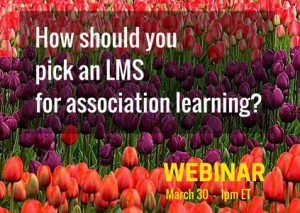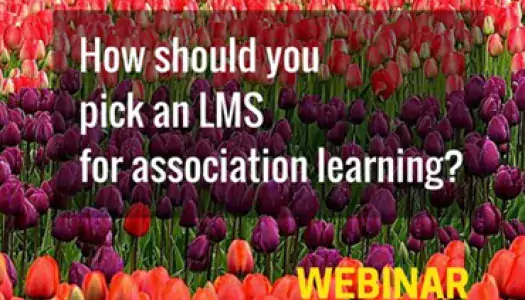There are over 675 viable Learning Management Systems solutions in the world and at first glance they all seem the same. They are not.
In a recent survey, we asked 72 diverse LMS vendors about the top 3 industries they compete in and found only 13 vendors (18%) listed associations as a core, primary focus. Interestingly, another 39 vendors (54%) said their LMS would work great for associations. 28% of vendors didn’t even try to pretend they understood the association space.
As it turns out, most of the 13 pure association focused vendors had some key commonalities the other vendors didn’t. Association LMS vendors know the non-profit world. The LMS vendor owners typically grew up in the association world. Many vendors started out supporting associations as an event, education or video advisor helping with annual tradeshows and events. Overtime these vendors started filming the breakout education sessions, putting them online and wrapping them with assessments. Without knowing or trying these association vendors evolved into association LMS vendors.
Corporate LMS started in HR/T&D departments with a focus on compliance management. Over decades, they learned that their LMS could be leveraged by associations if the requirements were straightforward. They understand learning management software and believe it is the same in any industry, but they have a general lack of awareness of the non-profit world. It is this group of LMS vendors that are typically poor LMS choices for associations. It’s not that they can’t technically match learners and content, they just don’t know what they don’t know about associations.
True association LMS vendors understand that it is their job to help associations:
- Increase revenue generation from sale of content and professional development
- Facilitate global expansion of association
- Elevate perceived value for the membership
- Realize economies of scale by creating and reusing great content
- Manage continuing education for members’ entire professional career
Specifically, here are five differences between an association and corporate LMS:
#1 Members vs. Employees Lingo
 Associations have members not employees. Sure, an association has a small staff of employees but the focus of the LMS is primarily for educating member audiences that can easily number in tens or hundreds of thousands. The typical nomenclature in a corporate LMS is tailored for employees, managers and administrators with terms such as department, group, compliance, hiring and required training.
Associations have members not employees. Sure, an association has a small staff of employees but the focus of the LMS is primarily for educating member audiences that can easily number in tens or hundreds of thousands. The typical nomenclature in a corporate LMS is tailored for employees, managers and administrators with terms such as department, group, compliance, hiring and required training.
True association LMS never had corporate lingo and all the terms, branding and functions are focused on members, commerce, social engagement, non-dues revenue, CE and accreditation.
#2 Voluntary vs. Mandatory Learners
Association LMS are primarily deployed to sell content to members and non-members in the same profession. Associations have completely voluntary learners who have other options for their continuing education content. Associations can’t force a voluntary learner to buy or consume content. Members have to want to. Members need to clearly see value, ease and measurable benefit or they will go elsewhere.
Corporations have mandatory employee users. Corporations can just force an employee to take training and they do. Not much thought needs to go into enticing and engaging users in that scenario.
#3 Free vs. Commerce
 Associations in 2016 have a mission to drive non-dues revenue through the sale of all types of content and publications. Associations sometimes have member organizations or individual members and sometimes both.
Associations in 2016 have a mission to drive non-dues revenue through the sale of all types of content and publications. Associations sometimes have member organizations or individual members and sometimes both.
An association LMS is more like an ecommerce website than a LMS. Filtered searching, featured content, advertising, promotions, discounts, subscriptions, bundles, audience-based pricing, client co-branding, content ratings & recommendations, social learning and 100% mobile responsiveness are features that don’t always appear in a typical corporate LMS but are mandatory in an association LMS.
#4 AMS vs. HRIS
 Associations have association management systems (AMS) and corporations have human resource information systems (HRIS). Both are the master repository of all information on learners and both can be integrated into an LMS. However, association management systems tend to have overlapping technology with an LMS as well as additional ecommerce, single-sign on, accreditation, licensing and workflow not standard in HRIS applications.
Associations have association management systems (AMS) and corporations have human resource information systems (HRIS). Both are the master repository of all information on learners and both can be integrated into an LMS. However, association management systems tend to have overlapping technology with an LMS as well as additional ecommerce, single-sign on, accreditation, licensing and workflow not standard in HRIS applications.
Additionally, there are many different types of AMS vendors with countless ways to configure and deploy so the association LMS needs to be incredibly malleable and flexible to support each association. All true association LMS have pre-built API connectors, or an integration bridge, to the major AMS solutions and the additional ability to extend the API to meet the associations unique AMS scenario if necessary.
Corporate LMS say they can integrate with AMS and will do it on a custom, reinvent the wheel basis.
#5 Continuing Education vs. Compliance
Professionals in almost every industry (doctors, lawyers, architects, auditors, barbers, real estate agents) have mandatory training requirements to earn and then maintain their right to practice their profession. To complicate matters, each state, province or country has its own regulations and licensing rules on most professions.
Managing the complexity of selling CE content from a LMS standpoint is difficult. Most corporate LMS vendors confuse compliance with continuing education. Both share the concept of completing content by a certain time and both have a window of validity after completion, but the similarities end there.
Association LMS can manage complex continuing education scenarios and allow associations to sell accredited continuing education content to their members and potential members.
Conclusion: Association and Corporate LMS are Different
There are 675+ LMS solutions in the world, but less than 13 specialize as a pure Association LMS, many more say they do. I’d try to use one of them if I was an association as they are expert in helping associations. However, even with the specialists there is a wide range of functional and professional service capability designed for different types of associations.
To choose wisely, the best defense is to define your association’s requirements specifically on a business, technical, functional and professional service level and use that as a tool to qualify potential LMS partners and compare apples to apples. Good luck!
Free Webinar: How to Select an Association (and not a corporate) LMS?
 We have a new free informational webinar you may be interested in -- How to Select an Association (and not a corporate) LMS on 3/30/2016 @ 1-2pm ET.
We have a new free informational webinar you may be interested in -- How to Select an Association (and not a corporate) LMS on 3/30/2016 @ 1-2pm ET.
Have you struggled to get your LMS to work in the way your association and your members need? If so, you probably own a corporate and not an association LMS.
Association LMS are special and the most unique of all LMS. Many LMS feature sets from webinar management, AMS integration, ecommerce, social and mobile are all more important than they are with employee LMS. More importantly, associations want vendors with hard core experience working within the association community. Finding the right association LMS with 650 potential choices can be challenging!
Register now!
Join me and Linda Bowers, CTO of WBT Systems to teach you how!
In this fast paced webinar we will discuss:
* Differences between employee and association LMS
* Basics of defining association requirements
* Determining the appropriate level of implementation services required
* 3-Step LMS Selection Process
* Real life case studies
Register even if you can't attend and we will send you a link to the recording.
About the Author
 John Leh is CEO and Lead Analyst at Talented Learning. John is an LMS selection consultant and eLearning industry blogger focused on helping organizations plan and implement technology strategies that support extended enterprise learning. John has 20 years of experience in the LMS industry, having served as a trusted adviser to more than 100 learning organizations with a total technology spend of more than $50 million. John helps organizations define their business case, identify requirements, short list vendors, write and manage the RFP and negotiate a great deal.
John Leh is CEO and Lead Analyst at Talented Learning. John is an LMS selection consultant and eLearning industry blogger focused on helping organizations plan and implement technology strategies that support extended enterprise learning. John has 20 years of experience in the LMS industry, having served as a trusted adviser to more than 100 learning organizations with a total technology spend of more than $50 million. John helps organizations define their business case, identify requirements, short list vendors, write and manage the RFP and negotiate a great deal.






